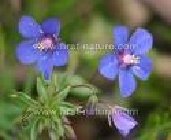|
Malva -- Lovely & HealingThe following information is directly quoted from the LINK BELOW. It is meant to be educational only...... this herb is an important ingredient in the cleansing herbs for the MOST IMPORTANT equine colic cure that I have used with 99.9999% success since 1977. The mucilages in blue malva flowers soothe sore throat caused by coughs and colds. Poultices of the flowers are also used to disinfect wounds. A complex polysaccharide in the herb known as arabinogalactose may have immune-stimulant properties.
Family: Malvaceae (hibiscus/mallow)
Other common names: Mallow, Country Mallow, Cheese Flower, Blue Mallow

History: Malva is an annual or perennial that is native to southern Europe and Asia and later introduced to North America. The plant may be cultivated or found wild in waste places, fields and along fences and roadsides in Europe and North America, growing to a height of four feet in well-drained to poor soil in sun or partial shade. The whitish root puts up a round stem, bearing alternate, light green, downy leaves and produces pink or purple flowers, which bloom from May to October. Like other mallows, it is one of the oldest medicinal plants in the world. It was used in teas in China more than five thousand years ago and employed by Greek and Roman physicians to treat internal and external disorders, calling it omnimorbium, meaning "the remedy of all illnesses." It continued as an important "cure-all" treatment throughout the Middle Ages, and like all mallows, it is principally known for its soothing qualities. It soothes irritated tissue, relieves various forms of inflammation
Beneficial Uses: Like all mallows, it is a demulcent, and its particular excellence involves soothing irritated tissue and relieving various forms of inflammation. The leaves contain high amounts of mucilage, made up of complex carbohydrates, which give the herb most of its soothing activity, though flavonoids and anthocyanidins may also contribute. It is effective in countering irritation and inflammation of the mucous membranes, and because it contains polysaccharides that form a protective layer on the stomach lining, it is said to lower stomach acids and is useful in relieving gastrointestinal disorders, such as gastric catarrh, enteritis, indigestion, ulcers and colitis.
As an expectorant, it is said to help loosen and expel phlegm and congestion from the lungs. It aids the body in expelling excess fluid and mucus, and because of its soothing, demulcent ualities, it not only removes phlegm, it also acts to soothe and relieve inflammation of the larynx and tonsils, dry coughs, sore throat, hoarseness, lung catarrh, bronchitis, asthma, emphysema and irritation of respiratory passages. The German Commission E has approved its preparations for the relief of sore throats and dry coughs. It is considered a mild laxative when used in larger doses. Early research in test tube studies shows one carbohydrate in mallows has been shown to inhibit a component of the immune system known as the complement cascade. Excessive activation of the complement cascade has been implicated in chronic inflammation and autoimmune disorders, suggesting that further research into these areas is warranted. It is said to have diuretic properties that increase the flow of urine. It has been used to soothe the urinary tract and relieve cystitis and bladder infection. Used externally, it is an emollient and demulcent that softens tissue and soothes damaged or inflamed surfaces, including dry hands, sunburn and diaper rash. In addition to its emollient qualities, it is also mildly astringent, and when included in poultices, it is helpful for sores, psoriasis, weeping eczema, boils, abscesses, insect bites and wounds.
|





